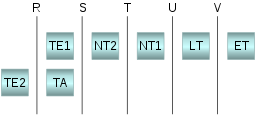Difference Between ISDN BRI and PRI
ISDN BRI vs PRI
 ISDN, or the Integrated Services Digital Network, is a very old set of standards created in 1988 for facilitating the transmission of digital data across typical telephone networks. This is used in order to deliver data services, the most prominent of which is internet access. Two of the three types of ISDN are PRI (which stands for Primary Rate Interface) and BRI (which stands for Basic Rate Interface). The main difference between the two is the level of service that they offer. PRI is the main service being offered while BRI is a basic service that provides the lowest level of performance but at a correspondingly low price.
ISDN, or the Integrated Services Digital Network, is a very old set of standards created in 1988 for facilitating the transmission of digital data across typical telephone networks. This is used in order to deliver data services, the most prominent of which is internet access. Two of the three types of ISDN are PRI (which stands for Primary Rate Interface) and BRI (which stands for Basic Rate Interface). The main difference between the two is the level of service that they offer. PRI is the main service being offered while BRI is a basic service that provides the lowest level of performance but at a correspondingly low price.
Actually, PRI and BRI are not that different at all. They both use B channels for transmitting the actual contents and D channels for signaling and other communications. The only difference is the number of channels that they use. BRI only uses 2 B channels, one up and one down, and a single D channel. In comparison, the number of channels used by PRI varies. The typical configuration in North America and Japan is 23 B channels with a single D channel. Another configuration is dual PRI with 46 B channels and 2 D channels to provide a back-up for the D channel. With each B channel transmitting at a rate of 64kbps, it is easy to see how this affects speed. BRI has a maximum speed of 128kbps for the two channels while PRI, for the examples above, can reach 1.47Mbps or double that at 2.94Mbps with dual PRI.
With those numbers, it is very clear how PRI can be far superior to BRI. And since PRI uses multiple channels, the direction can be configured in order to accommodate whichever needs the most bandwidth. This is not really feasible with BRI, as it only has one channel for each direction. PRI was preferred by large companies due to the speed it provides as well as its flexibility. Back in the days before broadband, BRI was the better alternative to the 56kbps connections and became very popular in Europe. But as broadband began to appear, BRI is also slowly losing ground in the consumer market.
Summary:
1.ISDN PRI is the main level service while the ISDN BRI is an entry level service
2.ISDN PRI uses more channels than ISDN BRI
3.ISDN PRI is faster than ISDN BRI
- Difference Between Sony Cybershot S Series and W Series - December 22, 2012
- Difference Between Samsung Galaxy S3 and iPhone 5 - December 21, 2012
- Difference Between Samsung Galaxy S2 (Galaxy S II) and Galaxy S 4G - December 20, 2012
Search DifferenceBetween.net :
1 Comment
Leave a Response
References :
[0]By Wersję rastrową wykonał użytkownik polskiego projektu wikipedii: Lucassus, Zwektoryzował: Krzysztof Zajączkowski [CC BY 2.5 (http://creativecommons.org/licenses/by/2.5)], via Wikimedia Commons

Hello
I am Richard and I just would like to share my experiences with you.
I experienced that my telephone system, Ozeki Phone System XE operates much better if it is used with broadband Internet connection. I would recommend to everyone that uses a telephone system, to subscribe for PRI lines.
Here you will find a detailed description of PRI: ozekiphone.com/what-is-pri-t1-331.html
Good luck! 🙂